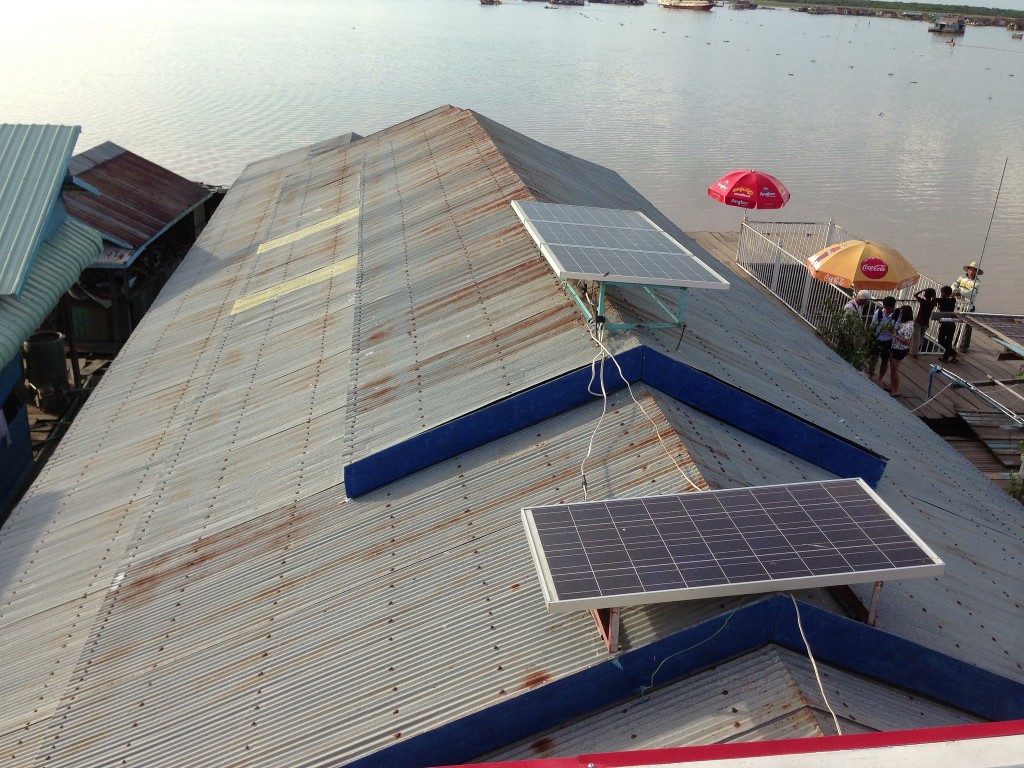ថាមពលកកើតឡើងវិញ គឺជាថាមពលដែលទាញមកពីប្រភពនានាដែលអាចជំនួសបាន ដូចជាដើមឈើ និងផ្នែកនានានៃដើមរុក្ខជាតិ ព្រះអាទិត្យ ឬខ្យល់។ វាមិនរាប់បញ្ជូលប្រេងឥន្ធនៈនោះទេ។
ជីវៈឧស្ម័ន
រោងចក្រជីវៈឧស្ម័ននឹងត្រូវបានតំឡើងនៅទូទាំងប្រទេសកម្ពុជាដើម្បីផ្តល់ថាមពលអគ្គីសនីដល់តំបន់ជនបទ យោងតាមសេចក្តីរាយការណ៍ របស់សារព័ត៌មានភ្នំពេញប៉ុស្តិ៍។ គម្រោងដែលមានរយៈពេល ១៥ ឆ្នាំនេះ ត្រូវបានដឹកនាំដោយ អង្គការអភិវឌ្ឍឧស្សាហកម្មសហប្រជាជាតិ និងទទួលបានមូលនិធិពីមូលនិធិបរិស្ថានពិភពលោក។ គម្រោងនេះ នឹងផលិតថាមពលអគ្គីសនីបានប្រមាណ ១.៥ មេហ្កាវ៉ាត់ក្នុងដំណាក់កាលដំបូង។1
ជីវៈឥន្ធនៈ
ប្រទេសកម្ពុជា ផលិតអង្កាមបានប្រមាណ ១.៦ លានតោនក្នុងមួយឆ្នាំ ហើយអង្កាម ២៥ ភាគរយ ត្រូវបានប្រើប្រាស់ជាជីវៈម៉ាសឥន្ធនៈ។2 អង្កាមប្រមាណ ១ លានតោន ត្រូវបានប៉ាន់ប្រមាណថា អាចផលិតថាមពលបាន ៦០ មេហ្កាវ៉ាត់។3 ក្រៅពីនេះ កម្ពុជាមានសក្តានុពលក្នុងការប្រើប្រាស់ដើមកៅស៊ូចាស់ៗ ប្រមាណ ២៥,០០០ តោន សម្រាប់ជាឈើឥន្ធនៈក្នុងមួយឆ្នាំ ទៀតផង។4
កាលពីខែ កញ្ញា ឆ្នាំ ២០១៤ ក្រុមហ៊ុនម៉ាឡេស៊ីឈ្មោះ PMTI Energy (Cambodia) បានចុះហត្ថលេខារួមលើកិច្ចព្រមព្រៀងរយៈពេល ១០ ឆ្នាំស្តីពីការផ្គត់ផ្គង់ថាមពលប្រមាណ ៤៨,០០០ មេហ្កាវ៉ាត់ ដែលផលិតចេញពីអង្កាមដល់ អគ្គីសនីកម្ពុជា ក្នុងតម្លៃ ០.០៩ ដុល្លាអាមេរិកក្នុងមួយគីឡូវ៉ាត់។5 កម្ពុជាមានសក្តានុពលក្នុងការផលិតជីវៈឥន្ធនៈពី ល្ហុងខ្វងប្រមាណ ១,០០០ ហិចតា ដូងប្រេងប្រមាណ ៤,០០០-១០,០០០ ហិចតា និងអំពៅប្រមាណ ២០,០០០ ហិចតា។6
ជីវៈម៉ាស
យោងតាម របាយការណ៍ប្រចាំឆ្នាំរបស់អាជ្ញាធរអគ្គីសនីកម្ពុជា ស្តីពីវិស័យថាមពលឆ្នាំ២០១៤ ក្រុមហ៊ុន Angkor Bio Cogen Co. Ltd. ក្រុមហ៊ុន Phnom Penh Sugar Co. Ltd. ក្រុមហ៊ុន IED Invest (Cambodia) និងក្រុមហ៊ុន Cam Chilbo Electric Power Co. Ltd. បានប្រើប្រាស់អុស និងផលិតផល ឬកាកសំណល់កសិកម្ម ជាថាមពលសម្រាប់ផលិតអគ្គីសនីក្នុងប្រទេសកម្ពុជា។7 គិតត្រឹមឆ្នាំ២០១៤នេះ ការផ្គត់ផ្គង់ថាមពលអគ្គីសនីដោយជីវៈម៉ាស មានកំណើនគួរឱ្យកត់សម្គាល់ ដោយសារតែការសាងសង់រោងចក្រជីវៈម៉ាសបន្ថែម មានការកើនឡើង។ ចាប់ពីឆ្នាំ២០១៣ ដល់ ឆ្នាំ២០១៤ ថាមពលអគ្គីសនីដែលផលិតចេញពីជីវៈម៉ាស បានកើនឡើងពី ៦.៦៨ លានគីឡូវ៉ាត់ម៉ោង ទៅដល់ ១៦.៧៩ លានគីឡូវ៉ាត់ម៉ោង។8
រោងចក្រកិនអំពៅរបស់ចិនដែលមានតម្លៃ ៣៦០ លានដុល្លារ ដែលបានដំណើរការនៅក្នុងខែ មេសា ឆ្នាំ ២០១៦ ក្នុងខេត្តព្រះវិហារ បានបន្ថែមការផលិតស្កររបស់ខ្លួន ដែលសមត្ថភាពផលិតអេតាណុលបាន ៥០,០០០ លីត្រក្នុងមួយឆ្នាំ និងថាមពលអគ្គិសនីដែលលើសបាន ៩ ម៉េហ្គាវ៉ាត់ផងដែរ។9
កំដៅក្នុងដី
មិនទាន់មានការប៉ាន់ប្រមាណពីថាមពលនេះនៅកម្ពុជាឡើយ។ ប្រទេសកម្ពុជាមានតំបន់តូចមួយដែលមានសកម្មភាពថាមពលកម្តៅដីនៅលើផ្ទៃដីដែលអាចមើលឃើញនឹងភ្នែកបាននៅក្នុងខេត្តកំពង់ស្ពឺ។
ថាមពលព្រះអាទិត្យ
ថាមពលព្រះអាទិត្យ ឬសូឡា កំពុងត្រូវបានប្រើប្រាស់កាន់តែច្រើន នៅតាមតំបន់ជនបទក្នុងប្រទេសកម្ពុជា។ ប្រព័ន្ធថាមពលព្រះអាទិត្យ ឬសូឡាតាមផ្ទះ ចំនួន ១២,០០០ បន្ទះ ត្រូវបានបំពាក់ក្នុងតំបន់ជនបទចាប់តាំងពីឆ្នាំ ២០១២ មកម៉្លេះ តាមរយៈមូលនិធិអគ្គីសនីភាវូបនីយកម្មជនបទ ដោយទទួលបានជំនួយពីអង្គការមិនមែនរដ្ឋាភិបាល។10
យោងតាមក្រសួងពាណិជ្ជកម្ម ក្រុមហ៊ុន Willowbrook ដែលជាក្រុមហ៊ុនអភិវឌ្ឍន៍ថាមពលកើតឡើងវិញមានមូលដ្ឋាននៅក្រុងញូវយ៉ក កំពុងស្វែងរកការគាំទ្រពីកម្ពុជា ដើម្បីសាងសង់រោងចក្រថាមពលព្រះអាទិត្យមានកម្លាំង ២៥០ មេហ្កាវ៉ាត់ ដែលអាចផលិតថាមពលអគ្គីសនីបានដល់ ៣៩៤ លានគីឡូវ៉ាត់ម៉ោង ក្នុងមួយឆ្នាំ។11
បញ្ហាប្រឈមមួយសម្រាប់ក្រុមហ៊ុនជាច្រើនដែលដំឡើងបន្ទះសូឡាសម្រាប់តម្រូវការថាមពលផ្ទាល់ខ្លួនរបស់ពួកគេនោះ គឺមិនមានតារាងតម្លៃលក់ដែលអនុញ្ញាតឱ្យពួកគេនាំចេញថាមពលអគ្គិសនីដែលផលិតលើសនោះទៅកាន់បណ្តាញជាតិនោះទេ។ រោងចក្រកាត់ដេរសម្លៀកបំពាក់មួយនៅក្នុងខេត្តសៀមរាប ដែលបានដំឡើងប្រព័ន្ធថាមពលសូឡាចំនួន ២៨០ បន្ទះនៅរោងចក្ររបស់ខ្លួន មិនអាចទទួលបានតម្លៃពេញត្រលប់ពីការវិនិយោគរបស់ពួកគេទៅលើថាមពលព្រះអាទិត្យនោះទេ ដោយសារតែរោងចក្រនេះមិនអាចលក់ថាមពលអគ្គិសនីដែលបានផលិតនៅពេលដែលរោចក្រមិនដំណើរការ។12
ថាមពលទឹកជោរ
មិនទាន់មានការប៉ាន់ប្រមាណពីថាមពលទឹកជោរនៅកម្ពុជាឡើយ។
ថាមពលខ្យល់
សៀវភៅផែនទី (Atlas) ក្នុងតំបន់អាស៊ីអាគ្នេយ៍ បានប៉ាន់ប្រមាណពីសក្តានុពលថាមពលខ្យល់សរុបនៅកម្ពុជាថាមានប្រមាណ ១,៣៨០ មេហ្កាវ៉ាត់។ គម្រោងថាមពលខ្យល់ ៧០០ គីឡូវ៉ាត់ កំពុងត្រូវបានអនុវត្តក្នុងខេត្តព្រៃវែង ដើម្បីធ្វើការបូមទឹក។13
បានធ្វើបច្ចុប្បន្នភាព៖ ២៧ កុម្ភៈ ២០១៧
ទាក់ទងនឹងផលិតកម្មថាមពលកើតឡើងវិញ
ឯកសារយោង
- 1. Baliga, Ananth និង សុធារី ប៉ិច. “ជីវៈឧស្ម័នសម្រាប់ផ្តល់ថាមពលដល់តំបន់ជនបទ.” កាសែតភ្នំពេញប៉ុស្តិ៍. ៧ កក្កដា ២០១៥, ផ្នែកសេដ្ឋកិច្ច. ដកស្រង់ ៧ កក្កដា ២០១៥. https://www.phnompenhpost.com/business/biogas-power-rural-areas
- 2. SNV “ការប្រើប្រាស់កាកសំណល់ ដើម្បីផលិតថាមពលសម្រាប់វិស័យកិនស្រូវនៅកម្ពុជា (W2E).” ដកស្រង់ ៥ សីហា ២០១៤. http://www.snvworld.org/en/cambodia/our-work/energy/W2E.
- 3. “កម្ពុជា.” ទិន្នន័យគម្រោងជីវៈឥន្ធនៈក្នុងបណ្តាប្រទេសនៅអាស៊ីអាគ្នេយ៍. ដកស្រង់ ២១ កញ្ញា ២០១៤. http://www.asiabiomass.jp/biofuelDB/about/index.htm.
- 4. Poch, K. (២០១៣), “ការអភិវឌ្ឍថាមពលកើតឡើងវិញនៅកម្ពុជា៖ ស្ថានភាព ទិសដៅអនាគត និងគោលនយោបាយ” ក្នុង Kimura, S., H. Phoumin និង B. Jacobs (eds.), សមាហរណកម្មទីផ្សារថាមពលក្នុងតំបន់អាស៊ីបូព៌ា៖ ថាមពលកើតឡើងវិញ និងការអភិវឌ្ឍវិស័យនេះទៅក្នុងប្រព័ន្ធថាមពល, របាយការណ៍គម្រោងស្រាវជ្រាវ ERIA ឆ្នាំ២០១២-២០២៦, ទីក្រុងហ្សាកាតា: ERIA. ទំព័រ ២២៧-២៦៦. http://www.eria.org/RPR_FY2012_No.26_chapter_7.pdf.
- 5. មុយហុង, ចាន់. “អង្កាមដើម្បីបង្កើតថាមពលសម្រាប់ផ្គត់ផ្គង់.” កាសែតភ្នំពេញប៉ុស្តិ៍. ១០ កញ្ញា ២០១៤. ដកស្រង់ ១៣ កញ្ញា ២០១៤. https://opendevelopmentcambodia.net/news/rice-husks-to-pump-energy-to-the-grid/
- 6. សិក្ខាសាលាស្តីពីថាមពលកើតឡើងវិញនៅអាស៊ី ឆ្នាំ២០១៣៖ ថាមពលកើតឡើងវិញរបស់កម្ពុជា ធ្វើបទបង្ហាញដោយ លោក ស៊ីន សំណាង (នាយកដ្ឋានបច្ចេកទេសថាមពលនៃ ក្រសួងឧស្សាហកម្ម រ៉ែ និងថាមពល).
- 7. អាជ្ញាធរអគ្គីសនីកម្ពុជា. ២០១៥. របាយការណ៍ប្រចាំឆ្នាំស្តីពីវិស័យថាមពលឆ្នាំ២០១៤. ភ្នំពេញ៖ អាជ្ញាធរអគ្គីសនីកម្ពុជា.
- 8. ដូចលេខយោងខាងលើ
- 9. សរ ចាន់ដារ៉ា. “រោងក្រកិនអំពៅដ៏ធំនឹងពង្រីកបន្ថែម.” កាសែតភ្នំពេញប៉ុស្តិ៍, ចុះថ្ងៃទី ២០ ខែ មេសា ឆ្នាំ ២០១៦. http://www.phnompenhpost.com/business/massive-sugar-mill-poised-expand
- 10. នាយកដ្ឋានមូលនិធិអគ្គិសនីភាវូបនីយកម្មជនបទ. “របាយការណ៍ស្តីពីសកម្មភាពរបស់នាយកដ្ឋានមូលនិធិអគ្គិសនីភាវូបនីយកម្មជនបទសម្រាប់ឆ្នាំ២០១៣.” http://ref.gov.kh/page/admin/public/filedownload/pro_ref%20report%202013_eg.pdf.
- 11. “អ្នកអភិវឌ្ឍវិស័យថាមពលកើតឡើងវិញរបស់អាមេរិកសំឡឹងមើលឱកាសវិនិយោគនៅកម្ពុជា” កាសែត Xinhua. ២២ សីហា ២០១៤. ដកស្រង់ ១ កក្កដា ២០១៥. http://news.xinhuanet.com/english/business/2014-08/22/c_133576584.htm.
- 12. Kali Kotoski. “វិស័យឯកជននៅតែប្រឈមនឹងតម្លៃអគ្គិសនីខ្ពស់”, កាសែតភ្នំពេញប៉ុស្តិ៍, ចុះថ្ងៃទី ១៦ ខែ កុម្ភៈ ឆ្នាំ ២០១៧. http://www.phnompenhpost.com/business/industry-leaders-voice-concern-over-sky-high-cost-electricity
- 13. M. Sarraf et al. ឯកសារពិនិត្យឡើងវិញលើថាមពលកើតឡើងវិញ និងប្រកបដោយនិរន្តរភាព (Renewable and Sustainable Energy Reviews. 22 ) (២០១៣) ២២៣–២២៩.


